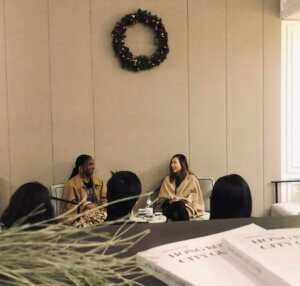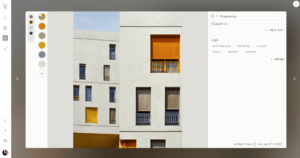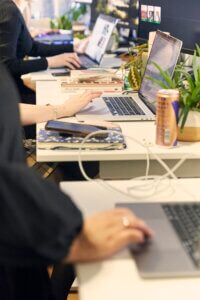“Urban exploration is about keeping an open mind and staying curious. I’ve always been interested in culture. I love spotting patterns, going beyond the obvious, and finding out what makes people tick.”
Cherie Yang
Founder of Visualist
Our Urban Explorer
Could you please introduce yourself to our guests?
I’m an entrepreneur, design lover, coffee drinker and one of those people who buys more books than I can read. In my day job, I’m the founder and CEO of Visualist.
For those who may not be familiar with the Visualist, could you tell us a bit more about how it works?
Visualist is an all-in-one workspace for creatives to organise their visual inspiration and work on collaborative projects.
Where did you come up with the idea for creating the Visualist?
I was sitting at my dining table fixing up digital moodboards when this idea—a very nascent one at that time—crept up on me. A tool for making a creative’s digital workflow easier.
I was working on a few creative projects at that time: a home rebuilds (which is still ongoing) and planning my own wedding. I was on Pinterest and Instagram a lot!
I felt 3 big pain points:
- I struggled to get a bird’s eye view of everything I had, and my ideas were scattered all over
- I was studiously filing everything into the ‘correct’ boards and folders, but really, who’s to say what’s correct? If I wanted something to be in both ‘Garden furniture’ and ‘Crazy ideas’ (I really did have a Pinterest board that was named that), I couldn’t do that. Not unless I duplicated the picture, which seemed crazy to me.
- Making mood boards was a pain. I was using PowerPoint (and I’m pretty good at it!) but it was time-consuming, and boring. It had all the mundanity, and none of the delight.
There was a lot more scratching of the head (mine), and picking of brains (others’). But many months later, I had a first working idea of what I wanted—and needed—Visualist to be.
How do you think the Visualist can bring true value to talents from various industries (HMU, Stylists, Content Creators, etc.) when it comes to carrying out their daily projects?
There are plenty of productivity tools. There’s Notion, Airtable, Trello, ClickUp and new ones popping up all the time. However, the fashion and creative industries typically lag behind when it comes to adopting them.
There are 2 main reasons:
- These tools aren’t made for creatives. We’re not working with text and numbers. We speak in visuals, and we need tools tailored for that language. In Visualist, the image is the building block. From there, you can take any number of actions on a block. Drop a sticky on it. Create a colour palette from it. Clip the block to projects. It’s simple, and it just makes sense.
- These tools are unintuitive and daunting, and take you out of your flow.
Visualist tackles these problems. We’re making organisation and collaboration a delight, and we’re saving you time.
What does a day in the life of Ms. Cherie Yang look like?
It varies so much across the week.
I keep Wednesdays reserved for deep work so my calendar is blocked out. The other days are less structured, but I do have my routines.
I’m a morning person, and I wake up at around 6:15 am. If I don’t have a breakfast meeting, I get into the office at around 7AM, and have my morning coffee. We have a ‘jungle-themed’ soundproof pod in our studio, and I try to meditate in there for 10 minutes. I must say that I’m not always successful!
This first part of the day is when my brain is the sharpest, so I tend to do strategy or creative work, until around 11AM. These days, I’m doing more in-person catch-ups socially, as it’s something I’ve really missed in the last year! Once a week, I fit in a lunchtime or coffee catch-up with a friend, usually in one of the cafes near the office.
Post-lunch is when we tend to do team discussions. As a team, we are really conscious about when, why, and how we do meetings, as they can easily become a time-suck. I enjoy brainstorming with the team about product design, development, and our marketing or community projects. It’s the end of the year so it feels like we’re spinning so many plates whilst wrapping up a lot of work too.
If I’m not in meetings, I usually do video calls in the afternoon in our pod. It could be interviewing someone for a feature in our ampersand magazine, user research calls with Visualist’s early adopters, or doing intro/demo calls with prospective users like interior designers and fashion stylists. I spend a lot of my time talking to users to really understand the why, before we get to the what and how.
Most evenings, I’m back at home for dinner with my fiancé, Josh. We’re also hooked on a few shows right now, like Succession, Selling Sunset and School of Chocolate, so that’s usually the weeknight chillout plan. If it’s a Friday, we head out for a nice dinner together.
All that said, my routine tends to go out of the window if I’m travelling, or if I’m just not feeling up to it. These days, I’m learning to listen to my body more. It’s a marathon, not a sprint!
What does “urban explorer” mean to you, and how do you think you fit into this term?
It’s about keeping an open mind and staying curious. I’ve always been interested in culture. I love spotting patterns, going beyond the obvious, and finding out what makes people tick.
Visualise It. Realise It.
So, prior to devoting your time to the Visualist, were you in the creative field?
I came into the creative field via a little detour. My first job was as a corporate lawyer in New York, and whilst I had always appreciated art, writing, fashion and design, I never would have thought of myself as a ‘creative’. I did start taking classes in interior design as a side project when I came back to London, but it wasn’t anything serious.
I later joined a strategic consultancy focused on advising luxury and lifestyle brands, and that was a whirlwind experience that allowed me to tap into my creative side. I’m so grateful for that experience—it was a true Eureka moment when I found that left brain-right brain connection.
Things naturally progressed from there and here I am!
We’re curious to know how the creative community is like in London. Could you tell us more based on your own experiences?
Wow, where do I start! We have an internal ‘bulletin board’ Slack channel at Visualist. We share exhibitions, projects, competitions or talks on there. A big thing we’re seeing is there are a lot of efforts to democratise access in the creative industries now.
On another level, I think we’re seeing people embrace being a ‘creative’ alongside other identities, and that squares with the multi-hyphenate zeitgeist. At our recent events, we’re seeing a lot more people dip their toes into a creative side hustle alongside their day jobs in finance, mental health, law and more!
We see that in many parts of the world, there is a flood of new start-ups and freelancers in the creative space. Do you think this trend applies to London and do you think it is here to stay?
The passion economy and the creator economy are the buzzwords of the 2020s. Whilst the U.S. is often where many of these movements take root, we’re also seeing them play out in London and the rest of the world.
We’re still at the very early days of seeing new ideas in the creative start-up landscape. Creative work is more flexible than ever, and the lines are blurred between doing creative work and living a creative life. Consumers and creators started with Etsy, and we now have Patreon, Gumroad, Cameo and so many others.
There are the Instagram chefs, TikTok fitness influencers, streamers, podcasters and designers. We’ll see lots of tools helping them to connect with their community, monetise their influence, and improve their creative workflows—the latter of which Visualist is doing for stylists and designers.
Many people have the misconception that fashion and design is all art and no science, but clearly this is not the case. How do you think science contributes to today’s fashion industry?
I think the distinction between art and science is almost artificial! Without getting too philosophical, I firmly believe that fashion is both an art and a science. ‘Art’ and ‘science’ are simply different lenses with which we perceive the world. Perhaps the misconception stems from thinking that fashion/design is all about creativity (the arts), and nothing about logic (science). Take one look at the concepts of colour and materials in fashion, and that misconception is instantly quashed.
What kind of technology trends do you predict for the future of fashion and design?
We’ll see artificial intelligence playing a big part in creativity tools. I like to think of it as: AI as a butler, assistant, or coach. We’re not taking away the power of creativity from the user. Technology can help automate many mundane processes, improve the quality of creative output, or provide creative prompts or nudges. We’ve seen it with Grammarly or the Hemingway app when it comes to writing, and we’ll see that with fashion and design.
Travel Inspiration
Creatives tend to have more flexibility when it comes to managing their own schedule. Pre-Covid, how often did you travel for work and leisure?
Most of my travel is for leisure. Being in London, we’re so fortunate to be able to travel easily within Europe for short weekend trips. San Sebastian and Paris are two of my favourite weekend destinations. It’s amazing what a short 2-day trip can do for the mind and soul.
I also love going on ski trips in the winter; France and Italy are my picks. I have to say, though, that gone are the days when we’d be the first out on the slopes when the lifts open. These days, we’re taking long leisurely breakfasts and plotting out ski routes based on which mountain restaurants we want to visit!
One side effect of the last two years is that I’ve spent a lot more time exploring the UK. Scotland is hugely underrated. I love it and I’m telling everyone who will listen about visiting Scotland.
Which places have you visited (anywhere in the world) that have inspired your work or made you think outside of the box?
New York: both the city and upstate NY. I used to live in NYC, and it’s a special city. It’s a mecca of excellence and energy, and you feel an innate desire to do more and be more. I love people-watching at Washington Square Park. There’s just so much life.
Upstate New York provides the counterbalance to that buzz. I love the Hudson Valley and the Catskills. I’ve always been a city person, but I really do love getting outside of the city for a little bit of stillness. There’s also a great art scene upstate, and Storm King Art Centre is a must-go.
I also visited Marfa, Texas many years ago. There’s so much great art there, but that’s not the thing that makes Marfa so inspiring. It’s the town itself. There’s nowhere like it and I hope it remains that way. It’s at once endlessly contemporary and resolutely stuck in the past.
Where does your inspiration for travel come from?
I view travel as a way of learning about cultures, and that’s what’s most appealing to me. I love hearing different languages, trying different cuisines, and learning about each place’s history.
It’s also a beautiful way to ground yourself. There’s nothing quite like being in the middle of the Amazon rainforest, with literally no end in sight, and feeling miniscule, in the best way. That’s why I love hiking and skiing trips. I feel inspired and recharged after.
What destinations are on your bucket list?
Ah, is there a limit?
My top 3 are: Montana, Alaska, Bhutan.
And also, practically all of South America. I’ve only been to Brazil, so there’s a lot more there to cover!
What is your impression of Londoners?
We are busy! Also, just like the city, we are always evolving.
Have there been any challenges and learnings of living in this city?
The biggest challenge, and also my biggest learning, is remembering to slow down.
How has this city inspired your work? Why?
I draw a lot of inspiration from people and places. I think the diversity of London in its people, neighbourhoods and energy has been the biggest fuel.
When you are not working or hosting workshops, which areas of London do you enjoy hanging out at most?
I live near Shoreditch, and our Visualist office is in Shoreditch, so I end up spending most of my time in east London. Pre-Covid, I used to go to Broadway Market almost every weekend with friends. We no longer go as often now, but it’s still one of my favourite hangouts for an easy spontaneous weekend. I love the buzz there.
During the warmer months, I love heading to Victoria Park. I literally lay out a mat, lie on the grass and read a book, and that makes me very happy.
I’m also always trying new restaurants, and a lot of my social life revolves around food! It feels like there’s a new breed of chefs who are establishing east London as the new go-to culinary destination, and I’m all for that. My current favourites (and coincidentally all fish-focused) are Cornerstone by Tom Brown, Behind by Andy Beynon, and The Sea The Sea (which started out as a fish shop in Chelsea!). I also went to Casa Fofo and I absolutely loved the food and the fact that it’s literally a neighbourhood restaurant in Hackney. What a gem.
I’m also regularly in Fitzrovia and Bloomsbury. There are great cafes and coffeeshops. I particularly like the London Review Bookshop. Cake, books and coffee or tea—definitely a potent combo for me and I can while away the hours.
For get-togethers with friends or meetings, I’m often in Soho and Mayfair. Shepherd Market is so quaint and one of my favourite spots. And it has a rather scandalous history!
Plus, Chinatown, for when I’m in search of good dim sum.
What must-have items do you carry with you when you go exploring in London?
I just need my phone! I use a Google Pixel.
Are there any London best-kept secrets that you can share with our audience?
Drum & Kernel in Dulwich has the best popcorn, hands down. They set up at street markets and their popcorn is freshly popped right in front of you. We first discovered them when they were selling at Broadway Market years ago, and we’d buy half a dozen bags each week. The guys would ask us if we were doing a big movie night (we weren’t). They’re no longer popping in east London, but we’ve followed them all the way to Dulwich in south-east London. It literally takes up to an hour to drive there. That’s pure devotion right there!
For beauty, I’ve been going to Rikyu in Muswell Hill for more than 7 years now. I get a facial there about once a month on Saturday mornings. It’s housed amongst a collection of artist studios in an old mews, and is such a lovely and tranquil spot up in North London. Emi, the owner, gives the best facial massage.
Katsute, a Japanese tea room in Angel’s Camden Passage, is one of my favourite places. I love getting a pot of tea and just sitting there to read a book or write in my notebook. It’s in my neighbourhood so it’s my go-to spot if I’m meeting someone for a cosy catch-up, or if I need to get something sweet last-minute when I’m hosting friends at mine. Their matcha crepe cake is my favourite, but you can’t really go wrong with anything. I’m not really sure it’s a secret anymore as it always seems busy now!
There’s a stationery shop called Present & Correct near Exmouth Market. I’m obsessed. They’ve got everything you didn’t know you wanted. Their Instagram and Twitter profiles are also pure perfection.
What makes this part of the world so special?
You think you know London, and you turn the corner and it surprises you. London’s different to different people. I guess London’s a bit of a chameleon, or a shape-shifter. I think that’s what makes it special.
When you need an escape outside the bustling city, which places would you recommend
to make a nice getaway by car?
Definitely the Cotswolds. It spans a large area geographically, and every bit has its charm. Whether you want nature, hiking trails, fancy hotels, culinary delights, art or history, there’s something for everyone. And it’s stunning, no matter the season.
Being a London local, how would you describe the city in 3 words?
Charming, Inspired, Inspiring


